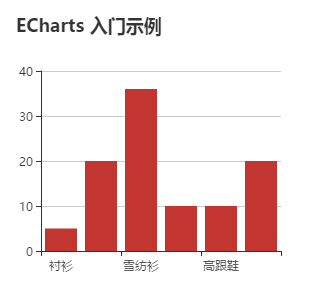Vue使用echarts
该示例使用 vue-cli 脚手架搭建
安装echarts依赖
npm install echarts -S
创建图表
全局引入
main.js
// 引入echarts import echarts from 'echarts' Vue.prototype.$echarts = echarts
<div id="myChart" :style="{ '300px', height: '300px'}"></div>
export default {
name: 'hello',
data () {
return {
msg: 'Welcome to Your Vue.js App'
}
},
mounted(){
this.drawLine();
},
methods: {
drawLine(){
// 基于准备好的dom,初始化echarts实例
let myChart = this.$echarts.init(document.getElementById('myChart'))
// 绘制图表
myChart.setOption({
title: { text: '在Vue中使用echarts' },
tooltip: {},
xAxis: {
data: ["衬衫","羊毛衫","雪纺衫","裤子","高跟鞋","袜子"]
},
yAxis: {},
series: [{
name: '销量',
type: 'bar',
data: [5, 20, 36, 10, 10, 20]
}]
});
}
}
}
注意: 这里echarts初始化应在钩子函数mounted()中,这个钩子函数是在el 被新创建的 vm.$el 替换,并挂载到实例上去之后调用
按需引入
上面全局引入会将所有的echarts图表打包,导致体积过大,所以我觉得最好还是按需引入。
Hello.vue
// 引入基本模板
let echarts = require('echarts/lib/echarts')
// 引入柱状图组件
require('echarts/lib/chart/bar')
// 引入提示框和title组件
require('echarts/lib/component/tooltip')
require('echarts/lib/component/title')
export default {
name: 'hello',
data() {
return {
msg: 'Welcome to Your Vue.js App'
}
},
mounted() {
this.drawLine();
},
methods: {
drawLine() {
// 基于准备好的dom,初始化echarts实例
let myChart = echarts.init(document.getElementById('myChart'))
// 绘制图表
myChart.setOption({
title: { text: 'ECharts 入门示例' },
tooltip: {},
xAxis: {
data: ["衬衫", "羊毛衫", "雪纺衫", "裤子", "高跟鞋", "袜子"]
},
yAxis: {},
series: [{
name: '销量',
type: 'bar',
data: [5, 20, 36, 10, 10, 20]
}]
});
}
}
}
这里之所以使用 require 而不是 import,是因为 require 可以直接从 node_modules 中查找,而 import 必须把路径写全。
页面展示:

参考自:https://blog.csdn.net/mr_wuch/article/details/70225364